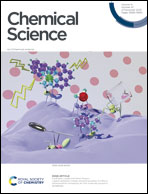Group 13 ion coordination to pyridyl breaks the reduction potential vs. hydricity scaling relationship for dihydropyridinates†
Abstract
The relationship Epvs. ΔGH– correlates the applied potential (Ep) needed to drive organohydride formation with the strength of the hydride donor that is formed: in the absence of kinetic effects Epvs. ΔGH– should be linear but it would be more energy efficient if Ep could be shifted anodically using kinetic effects. Biological hydride transfers (HT) performed by cofactors including NADH and lactate racemase do occur at low potentials and functional modeling of those processes could lead to low energy HT reactions in electrosynthesis and to accurate models for cofactor chemistry. Herein we probe the influence of N-alkylation or N-metallation on ΔGH– for dihydropyridinates (DHP−) and on Ep of the DHP− precursors. We synthesized a series of DHP− complexes of the form (pz2HP−)E via hydride transfer from their respective [(pz2P)E]+ forms where E = AlCl2+, GaCl2+ or Me+. Relative ΔGH– for the (pz2HP−)E series all fall within 1 kcal mol−1, and ΔGH– for (pz2HP)CH3 was approximated as 47.5 ± 2.5 kcal mol−1 in MeCN solution. Plots of Epvs. ΔGH– including [(pz2P)E]+ suggest kinetic effects shift Ep anodically by ∼215 mV.



 Please wait while we load your content...
Please wait while we load your content...